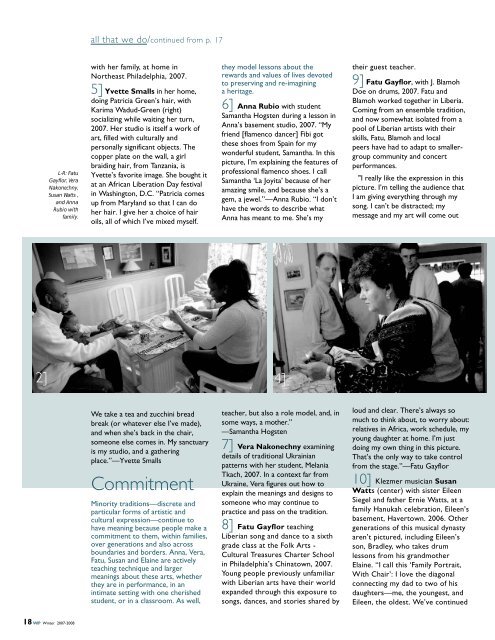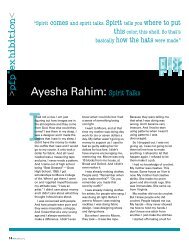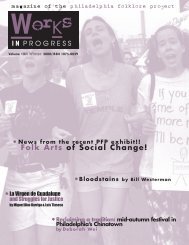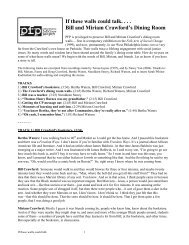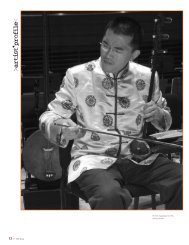African song / Fatu Gayflor ⢠War and wealth - Philadelphia Folklore ...
African song / Fatu Gayflor ⢠War and wealth - Philadelphia Folklore ...
African song / Fatu Gayflor ⢠War and wealth - Philadelphia Folklore ...
Create successful ePaper yourself
Turn your PDF publications into a flip-book with our unique Google optimized e-Paper software.
all that we do/continued from p. 17<br />
L-R: <strong>Fatu</strong><br />
<strong>Gayflor</strong>, Vera<br />
Nakonechny,<br />
Susan Watts ,<br />
<strong>and</strong> Anna<br />
Rubio with<br />
family.<br />
with her family, at home in<br />
Northeast <strong>Philadelphia</strong>, 2007.<br />
5] Yvette Smalls in her home,<br />
doing Patricia Green’s hair, with<br />
Karima Wadud-Green (right)<br />
socializing while waiting her turn,<br />
2007. Her studio is itself a work of<br />
art, filled with culturally <strong>and</strong><br />
personally significant objects. The<br />
copper plate on the wall, a girl<br />
braiding hair, from Tanzania, is<br />
Yvette’s favorite image. She bought it<br />
at an <strong>African</strong> Liberation Day festival<br />
in Washington, D.C. “Patricia comes<br />
up from Maryl<strong>and</strong> so that I can do<br />
her hair. I give her a choice of hair<br />
oils, all of which I’ve mixed myself.<br />
they model lessons about the<br />
rewards <strong>and</strong> values of lives devoted<br />
to preserving <strong>and</strong> re-imagining<br />
a heritage.<br />
6] Anna Rubio with student<br />
Samantha Hogsten during a lesson in<br />
Anna’s basement studio, 2007. “My<br />
friend [flamenco dancer] Fibi got<br />
these shoes from Spain for my<br />
wonderful student, Samantha. In this<br />
picture, I’m explaining the features of<br />
professional flamenco shoes. I call<br />
Samantha ‘La Joyita’ because of her<br />
amazing smile, <strong>and</strong> because she’s a<br />
gem, a jewel.”—Anna Rubio. “I don’t<br />
have the words to describe what<br />
Anna has meant to me. She’s my<br />
their guest teacher.<br />
9] <strong>Fatu</strong> <strong>Gayflor</strong>, with J. Blamoh<br />
Doe on drums, 2007. <strong>Fatu</strong> <strong>and</strong><br />
Blamoh worked together in Liberia.<br />
Coming from an ensemble tradition,<br />
<strong>and</strong> now somewhat isolated from a<br />
pool of Liberian artists with their<br />
skills, <strong>Fatu</strong>, Blamoh <strong>and</strong> local<br />
peers have had to adapt to smallergroup<br />
community <strong>and</strong> concert<br />
performances.<br />
"I really like the expression in this<br />
picture. I’m telling the audience that<br />
I am giving everything through my<br />
<strong>song</strong>. I can’t be distracted; my<br />
message <strong>and</strong> my art will come out<br />
2] 4]<br />
We take a tea <strong>and</strong> zucchini bread<br />
break (or whatever else I’ve made),<br />
<strong>and</strong> when she’s back in the chair,<br />
someone else comes in. My sanctuary<br />
is my studio, <strong>and</strong> a gathering<br />
place.”—Yvette Smalls<br />
Commitment<br />
Minority traditions—discrete <strong>and</strong><br />
particular forms of artistic <strong>and</strong><br />
cultural expression—continue to<br />
have meaning because people make a<br />
commitment to them, within families,<br />
over generations <strong>and</strong> also across<br />
boundaries <strong>and</strong> borders. Anna, Vera,<br />
<strong>Fatu</strong>, Susan <strong>and</strong> Elaine are actively<br />
teaching technique <strong>and</strong> larger<br />
meanings about these arts, whether<br />
they are in performance, in an<br />
intimate setting with one cherished<br />
student, or in a classroom. As well,<br />
teacher, but also a role model, <strong>and</strong>, in<br />
some ways, a mother.”<br />
—Samantha Hogsten<br />
7] Vera Nakonechny examining<br />
details of traditional Ukrainian<br />
patterns with her student, Melania<br />
Tkach, 2007. In a context far from<br />
Ukraine, Vera figures out how to<br />
explain the meanings <strong>and</strong> designs to<br />
someone who may continue to<br />
practice <strong>and</strong> pass on the tradition.<br />
8] <strong>Fatu</strong> <strong>Gayflor</strong> teaching<br />
Liberian <strong>song</strong> <strong>and</strong> dance to a sixth<br />
grade class at the Folk Arts -<br />
Cultural Treasures Charter School<br />
in <strong>Philadelphia</strong>’s Chinatown, 2007.<br />
Young people previously unfamiliar<br />
with Liberian arts have their world<br />
exp<strong>and</strong>ed through this exposure to<br />
<strong>song</strong>s, dances, <strong>and</strong> stories shared by<br />
loud <strong>and</strong> clear. There’s always so<br />
much to think about, to worry about:<br />
relatives in Africa, work schedule, my<br />
young daughter at home. I’m just<br />
doing my own thing in this picture.<br />
That’s the only way to take control<br />
from the stage.”—<strong>Fatu</strong> <strong>Gayflor</strong><br />
10] Klezmer musician Susan<br />
Watts (center) with sister Eileen<br />
Siegel <strong>and</strong> father Ernie Watts, at a<br />
family Hanukah celebration, Eileen’s<br />
basement, Havertown. 2006. Other<br />
generations of this musical dynasty<br />
aren’t pictured, including Eileen’s<br />
son, Bradley, who takes drum<br />
lessons from his gr<strong>and</strong>mother<br />
Elaine. “I call this ‘Family Portrait,<br />
With Chair’: I love the diagonal<br />
connecting my dad to two of his<br />
daughters—me, the youngest, <strong>and</strong><br />
Eileen, the oldest. We’ve continued<br />
18 WIP Winter 2007-2008


